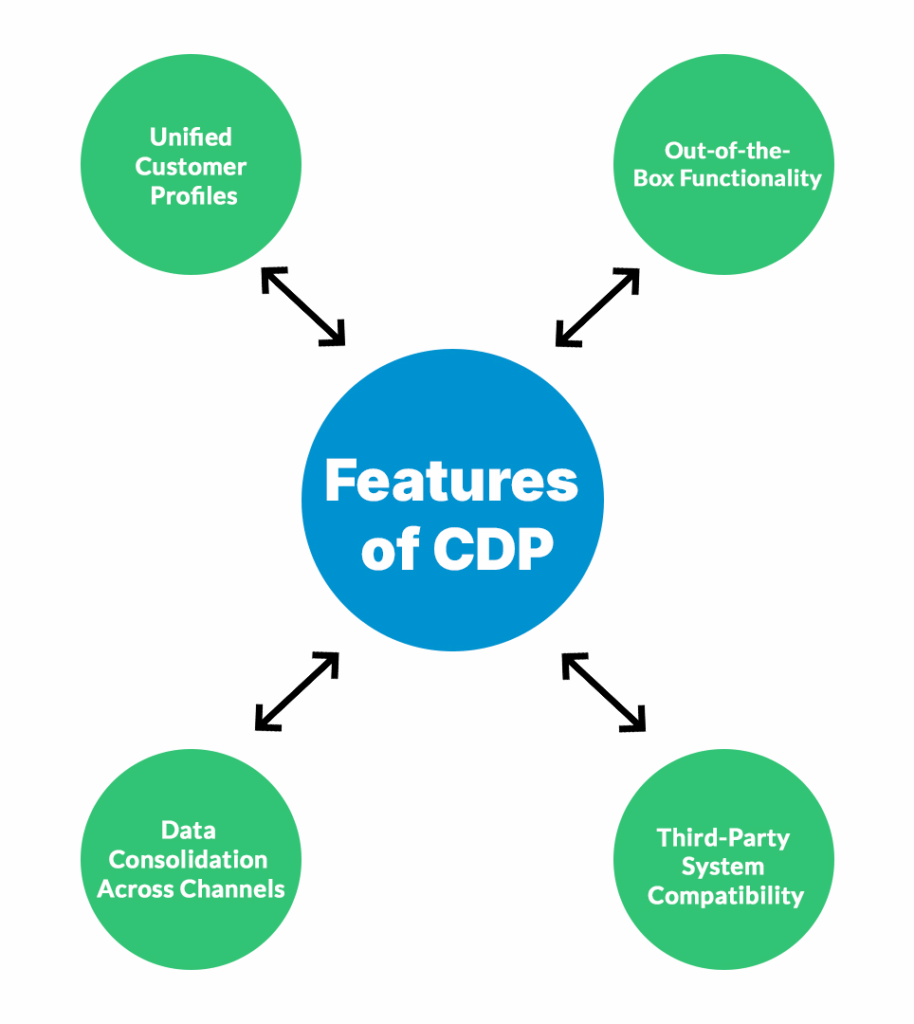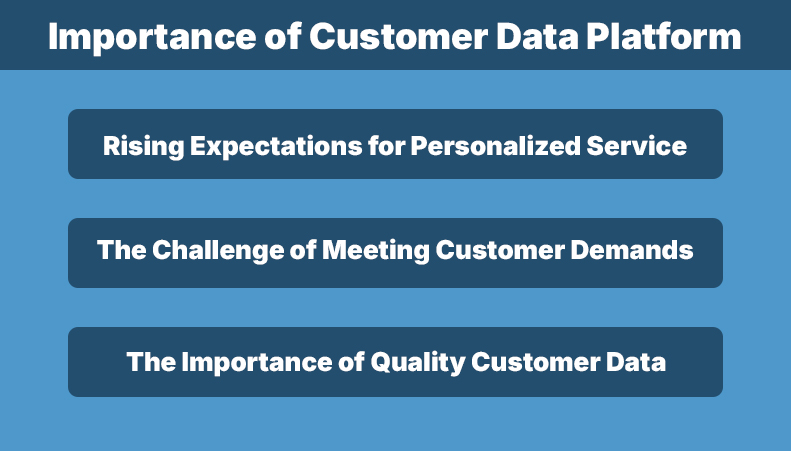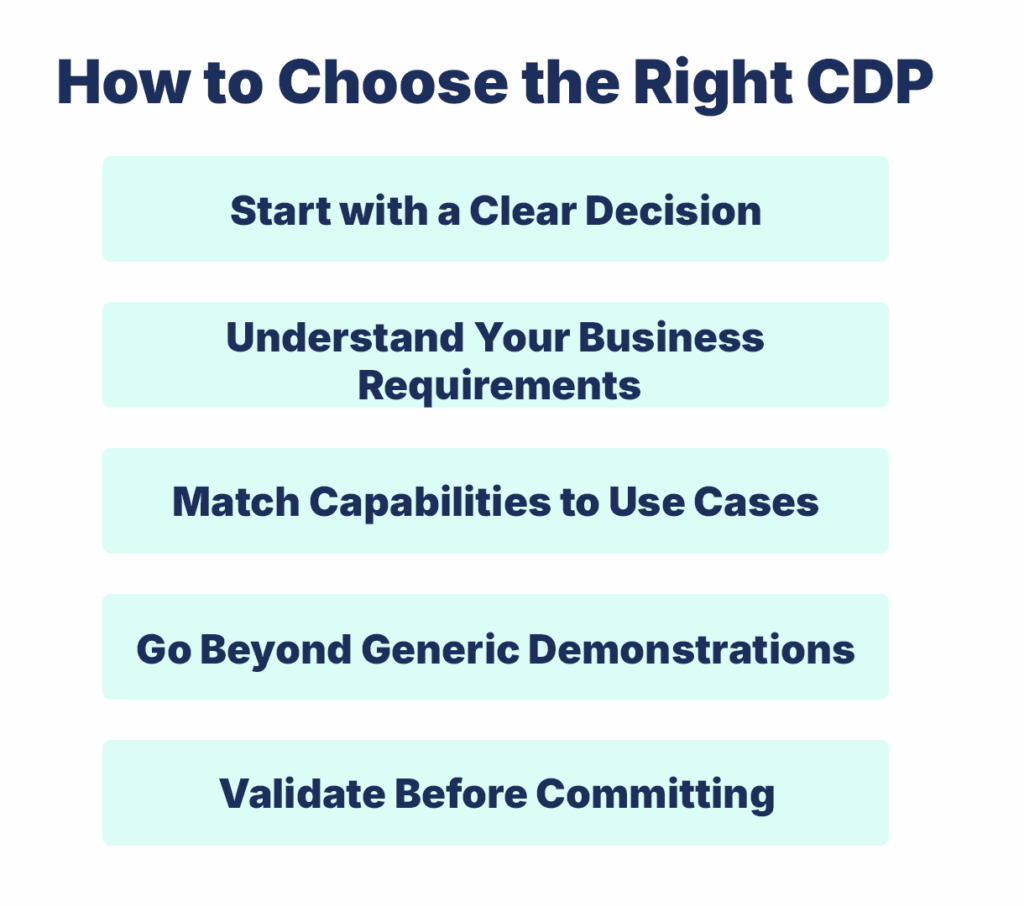Table of Contents
Introduction
A Customer Data Platform (CDP) is a type of marketing technology software designed to unify and manage customer data. It functions as a centralized database that stores detailed, long-term records of your customers, including their characteristics and interactions.
The primary role of a CDP is to gather and consolidate first-party data, such as behavioral, demographic, and transactional information, from various sources. It then connects all that data to the individual customer who generated it.
In this blog, we’ll explore what a Customer Data Platform (CDP) is and why it’s becoming an essential tool for modern marketing. You’ll learn how a CDP works, what types of customer data it collects, and how it helps businesses build a single, unified view of each customer.
Features of CDP

While many companies offer different types of CDPs, the most effective platforms share several key features that every marketer should prioritize:
- Out-of-the-Box Functionality: While some technical setup and maintenance may be necessary, these platforms typically require far less technical expertise than managing a traditional data warehouse.
- Unified Customer Profiles: This single-customer view offers a comprehensive, 360-degree perspective, making it easier to understand and engage with each customer.
- Data Consolidation Across Channels: A quality CDP merges inconsistent data from various online and offline channels to produce a consistent, unified profile for every customer.
- Third-Party System Compatibility: CDPs are built to make data easily accessible and ready for use across third-party platforms, including advertising technologies and marketing campaign tools.
Importance of Customer Data Platform

- Rising Expectations for Personalized Service: Customers now expect a lot from businesses. Having experienced personalized, attentive service, they demand that same high standard consistently.
- The Challenge of Meeting Customer Demands: Many companies struggle to deliver these tailored experiences effectively. Failing to meet these elevated expectations can quickly drive customers away.
- The Importance of Quality Customer Data: A reliable Customer Data Platform (CDP) makes this possible by helping you gather and organize the right data to better understand and engage your customers.
Types of Customer Data Platforms
As the Customer Data Platform (CDP) market has evolved, a wide range of providers has emerged, each offering different capabilities tailored to specific use cases and business needs.

- Data Consolidation and Unification: These foundational customer data platforms (CDPs) are designed to gather and merge customer data from a wide variety of sources, including mobile apps, third-party sites, CRM systems, and social media channels.
- Identity and Engagement: Building upon the basic functionality of data unification, identity and engagement CDPs go further by applying artificial intelligence to cleanse the data, eliminate duplicates, and create accurate, detailed customer profiles.
- Automated Analytics: With automated analytics CDPs, businesses can bypass the need for large analytics teams to manually interpret customer data. These platforms use AI to automatically analyze data and generate insights based on customer profiles.
- Automated Actions: They handle everything—from data collection and profile creation to analytics and execution of data-driven marketing actions—helping tech-savvy organizations streamline and scale their customer engagement strategies with minimal manual input.
How to Choose the Right CDP

- Start with a Clear Decision: Once you’ve decided that a Customer Data Platform (CDP) is the right solution for your business, the next challenge is selecting the vendor that best fits your needs.
- Understand Your Business Requirements: Begin by identifying your specific use cases. Knowing exactly how you plan to use the CDP will help define your technical and strategic requirements.
- Match Capabilities to Use Cases: Once you’ve outlined your needs, research vendors that align with those goals. It’s essential to evaluate whether each platform can support your actual use cases, not just what looks good on paper.
- Go Beyond Generic Demonstrations: Avoid relying on pre-packaged demos that only showcase a vendor’s ideal scenarios. Instead, request a demonstration based on a real-world use case relevant to your business.
- Validate Before Committing: Before making a final decision, consider issuing a Request for Proposal (RFP) or conducting a pilot project. This allows you to test the platform’s capabilities and ensure it meets your expectations in a live setting.
Benefits of a Customer Data Platform
To successfully build a Customer Data Platform (CDP), three fundamental steps serve as the backbone of its functionality.

- Online-to-Offline Connection: Unify customer activity across digital and physical channels. Identify users from online interactions when they visit brick-and-mortar stores to build more accurate, complete customer profiles.
- Customer Segmentation and Personalization: Group customers based on behavioral data like RFM (Recency, Frequency, Monetary value) or predicted lifetime value (LTV).
- Predictive Customer Scoring: Enrich profiles with predictive insights such as likelihood to purchase, churn probability, visit frequency, or email engagement. These scores help prioritize marketing efforts and personalize outreach.
- Smart Retargeting & Lookalike Advertising: Integrate with platforms like Facebook Ads, Google Ads, and Google Analytics to leverage behavioral data for retargeting campaigns and lookalike audience acquisition across multiple channels.
- Intelligent Product Recommendations: Deploy dynamic recommendation models like “similar items” or “customers also bought.” These improve the shopping experience, boost engagement, and help drive upselling and cross-selling opportunities.
- Conversion Rate Optimization & A/B Testing: Enhance your website’s performance with smart overlays (e.g., pop-ups) and cart abandonment campaigns. Use automated A/B testing to compare design or messaging variants and optimize for better results.
How to Build a Customer Data Platform
To successfully build a Customer Data Platform (CDP), three fundamental steps serve as the backbone of its functionality.

Data Integration
The foundation of any CDP starts with bringing together customer data from multiple sources into one centralized system. This step focuses on breaking down data silos by connecting various tools, platforms, and databases, ensuring all your customer information lives in one accessible location.
Data Structuring and Cleansing
Once data is collected, it needs to be refined. This means cleaning up the data by eliminating duplicates, filling in missing fields, and validating accuracy. A well-structured dataset allows you to create meaningful audience segments and improves the reliability of any analysis or automation that follows.
Identity Resolution and Unification
This is where the CDP begins to add value—by matching and merging data from different sources to create a complete view of each customer. Through identity resolution, the platform links all relevant data points to individual profiles, allowing you to track behavior and preferences over time and gain actionable insights.
Conclusion
A Customer Data Platform (CDP) is more than just a data management tool—it’s the foundation for delivering personalized, consistent, and meaningful customer experiences at scale.
Choosing the right CDP means understanding your business goals, identifying the specific use cases you need, and selecting a solution that fits seamlessly into your existing tech stack.
In a world where customer expectations are constantly rising, having accurate, accessible, and real-time customer data is no longer optional—it’s essential. With the right strategy and the right platform, your business can move from reactive marketing to proactive, data-driven growth.
Deepak Wadhwani has over 20 years experience in software/wireless technologies. He has worked with Fortune 500 companies including Intuit, ESRI, Qualcomm, Sprint, Verizon, Vodafone, Nortel, Microsoft and Oracle in over 60 countries. Deepak has worked on Internet marketing projects in San Diego, Los Angeles, Orange Country, Denver, Nashville, Kansas City, New York, San Francisco and Huntsville. Deepak has been a founder of technology Startups for one of the first Cityguides, yellow pages online and web based enterprise solutions. He is an internet marketing and technology expert & co-founder for a San Diego Internet marketing company.



